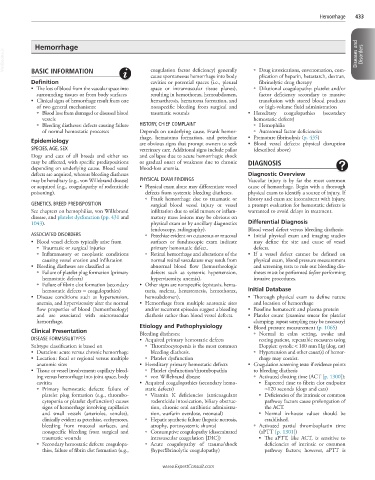Page 894 - Cote clinical veterinary advisor dogs and cats 4th
P. 894
Hemorrhage 433
Hemorrhage
VetBooks.ir Diseases and Disorders
coagulation factor deficiency) generally
BASIC INFORMATION
cause spontaneous hemorrhage into body ○ Drug intoxications, envenomation, com-
plication of heparin, hetastarch, dextran,
Definition cavities or potential spaces (i.e., pleural fibrinolytic drug therapy
• The loss of blood from the vascular space into space or intramuscular tissue planes), ○ Dilutional coagulopathy: platelet and/or
surrounding tissues or from body surfaces resulting in hemothorax, hemoabdomen, factor deficiency secondary to massive
• Clinical signs of hemorrhage result from one hemarthrosis, hematoma formation, and transfusion with stored blood products
of two general mechanisms: nonspecific bleeding from surgical and or high-volume fluid administration
○ Blood loss from damaged or diseased blood traumatic wounds • Hereditary coagulopathies (secondary
vessels hemostatic defects)
○ Bleeding diatheses: defects causing failure HISTORY, CHIEF COMPLAINT ○ Hemophilia
of normal hemostatic processes Depends on underlying cause. Frank hemor- ○ Autosomal factor deficiencies
rhage, hematoma formation, and petechiae • Premature fibrinolysis (p. 435)
Epidemiology are obvious signs that prompt owners to seek • Blood vessel defects: physical disruption
SPECIES, AGE, SEX veterinary care. Additional signs include pallor (described above)
Dogs and cats of all breeds and either sex and collapse due to acute hemorrhagic shock
may be affected, with specific predispositions or gradual onset of weakness due to chronic DIAGNOSIS
depending on underlying cause. Blood vessel blood-loss anemia.
defects are acquired, whereas bleeding diatheses Diagnostic Overview
may be hereditary (e.g., von Willebrand disease) PHYSICAL EXAM FINDINGS Vascular injury is by far the most common
or acquired (e.g., coagulopathy of rodenticide • Physical exam alone may differentiate vessel cause of hemorrhage. Begin with a thorough
poisoning). defects from systemic bleeding diatheses. physical exam to identify a source of injury. If
○ Frank hemorrhage due to traumatic or history and exam are inconsistent with injury,
GENETICS, BREED PREDISPOSITION surgical blood vessel injury or vessel a prompt evaluation for hemostatic defects is
See chapters on hemophilias, von Willebrand infiltration due to solid tumors or inflam- warranted to avoid delays in treatment.
disease, and platelet dysfunction (pp. 431 and matory mass lesions may be obvious on
1043). physical exam or by ancillary diagnostics Differential Diagnosis
(endoscopy, radiography). Blood vessel defect versus bleeding diathesis:
ASSOCIATED DISORDERS ○ Petechiae evident on cutaneous or mucosal • Initial physical exam and imaging studies
• Blood vessel defects typically arise from surfaces or funduscopic exam indicate may define the site and cause of vessel
○ Traumatic or surgical injuries primary hemostatic defect. defects.
○ Inflammatory or neoplastic conditions ○ Retinal hemorrhage and alterations of the • If a vessel defect cannot be defined on
causing vessel erosion and infiltration normal retinal vasculature may result from physical exam, blood pressure measurement
• Bleeding diatheses are classified as abnormal blood flow (hemorrheologic and screening tests to rule out bleeding dia-
○ Failure of platelet plug formation (primary defects such as systemic hypertension, theses must be performed before performing
hemostatic defects) hyperviscosity, anemia). invasive procedures.
○ Failure of fibrin clot formation (secondary • Other signs are nonspecific (epistaxis, hema-
hemostatic defects = coagulopathies) turia, melena, hematemesis, hemothorax, Initial Database
• Disease conditions such as hypertension, hemoabdomen). • Thorough physical exam to define nature
anemia, and hyperviscosity alter the normal • Hemorrhage from multiple anatomic sites and location of hemorrhage
flow properties of blood (hemorrheology) and/or recurrent episodes suggest a bleeding • Baseline hematocrit and plasma protein
and are associated with microvascular diathesis rather than blood vessel defects. • Platelet count (examine smear for platelet
hemorrhage. clumping; repeat sampling may be necessary)
Etiology and Pathophysiology • Blood pressure measurement (p. 1065)
Clinical Presentation Bleeding diatheses: ○ Normal in calm setting, awake and
DISEASE FORMS/SUBTYPES • Acquired primary hemostatic defects resting patient, repeatable measures using
Subtype classification is based on ○ Thrombocytopenia is the most common Doppler: systolic < 180 mm Hg (dog, cat)
• Duration: acute versus chronic hemorrhage bleeding diathesis. ○ Hypertension and other cause(s) of hemor-
• Location: focal or regional versus multiple ○ Platelet dysfunction rhage may coexist.
anatomic sites • Hereditary primary hemostatic defects • Coagulation screening tests: if evidence points
• Tissue or vessel involvement: capillary bleed- ○ Platelet dysfunction/thrombopathia to bleeding diathesis
ing versus hemorrhage into joint space, body ○ von Willebrand disease ○ Activated clotting time (ACT [p. 1300]):
cavities • Acquired coagulopathies (secondary hemo- ■ Expected time to fibrin clot endpoint
○ Primary hemostatic defects: failure of static defects) ≈120 seconds (dogs and cats)
platelet plug formation (e.g., thrombo- ○ Vitamin K deficiencies (anticoagulant ■ Deficiencies of the intrinsic or common
cytopenia or platelet dysfunction) causes rodenticide intoxication, biliary obstruc- pathway factors cause prolongation of
signs of hemorrhage involving capillaries tion, chronic oral antibiotic administra- the ACT.
and small vessels (arterioles, venules), tion, warfarin overdose, neonatal) ■ Normal in-house values should be
clinically evident as petechiae, ecchymoses, ○ Hepatic synthetic failure (hepatic necrosis, established.
bleeding from mucosal surfaces, and atrophy, portosystemic shunts) ○ Activated partial thromboplastin time
nonspecific bleeding from surgical and ○ Consumptive coagulopathy (disseminated (aPTT [p. 1301])
traumatic wounds intravascular coagulation [DIC]) ■ The aPTT, like ACT, is sensitive to
○ Secondary hemostatic defects: coagulopa- ○ Acute coagulopathy of trauma/shock deficiencies of intrinsic or common
thies, failure of fibrin clot formation (e.g., (hyperfibrinolytic coagulopathy) pathway factors; however, aPTT is
www.ExpertConsult.com

